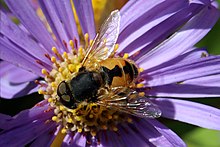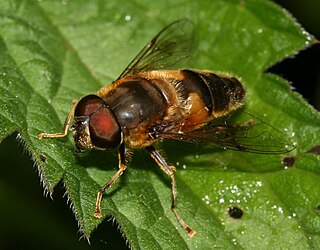
Eristalis pertinax is a hoverfly in the family Syrphidae. It was first described by Giovanni Antonio Scopoli in 1763 and is found in Asia and Europe. Like Eristalis tenax, the larvae of E. pertinax are rat-tailed maggots living in drainage ditches, pools around manure piles, sewage, and similar places containing water with high organic load and low oxygen concentration.

Eristalis nemorum is a species of hoverfly. It is found in the Palearctic and in the Nearctic.

Myathropa florea, sometimes referred to as the Batman hoverfly, is a very common European and North African species of hoverfly. Adults may be seen on flowers from May to September. It is of a similar size to the common drone fly, but Myathropa are generally more yellow, with two light bands to the thorax, interrupted with a black central smudge. In museum specimens, any yellow colour soon fades to brown after death. Like most species in the tribe Eristalini, Myathropa are rather variable in size, shape and colour.
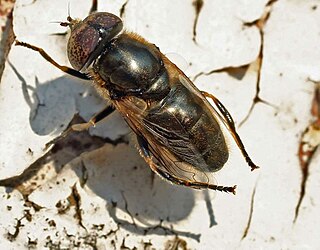
Eristalinus sepulchralis is a European species of hoverfly. The species are brownish-white from a close up, and look like a wasp. From a distance though, they are yellowish-black coloured, and look like a bumble bee. The species can be found throughout Europe in the Baltic states, North Europe, Central, Southern and Western Europe and across the Palaearctic to Kamchatka, Japan, China and India. Finland, Great Britain, Hungary, Ireland, Norway, and the Netherlands.

Eristalis intricaria is a European species of hoverfly. It is a furry bee mimic, superficially resembling Merodon, though Merodon have all black leg tibiae, as opposed to partly yellow. E. intricaria is somewhat variable in colour pattern, and some attempts at naming varieties have been tentatively made. Flight time of adults in the UK are from March to September. It is generally widespread, but is seldom seen in large numbers. Habitat is woodland or marshland.
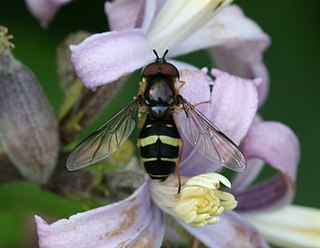
Dasysyrphus tricinctus is a European species of hoverfly in the genus Dasysyrphus, a member of the family Syrphidae. It is found across Europe, although reported in highest density from the British Isles and Scandinavia. While not uncommon it is generally only seen in modest numbers, typically in lowland woods with peak numbers in late May and early June and again in late August and early September.
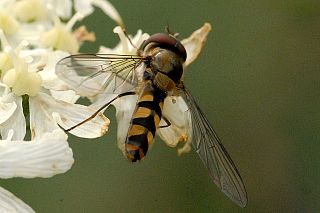
Meliscaeva auricollis is a West Palearctic species of hoverfly.

Parasyrphus annulatus is a Palearctic species of hoverfly.

Eristalis abusiva is a European species of hoverfly. It is similar to Eristalis arbustorum.
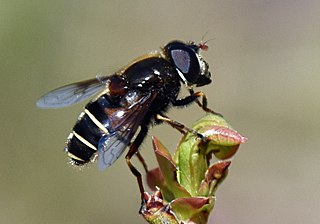
Eristalis cryptarum is a holarctic species of hoverfly. Known as the bog hoverfly or bog-dwelling drone fly, it is a bog specialist but may occur in other wetlands. Its larvae are assumed to live in peat that is saturated with water, such as that found in these boggy areas. The female has been observed depositing eggs on and close to very fresh cow dung along oligotrophic seepages in moorland.
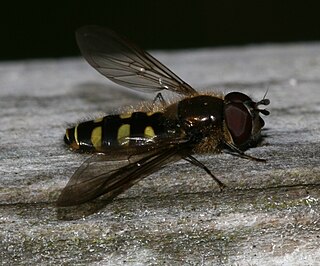
Melangyna lasiophthalma is a Holarctic species of hoverfly.

Epistrophe grossulariae is a Holarctic species of hoverfly.
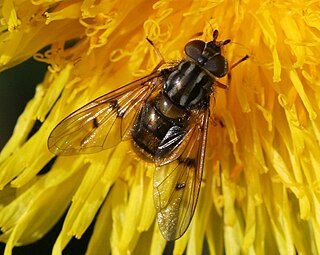
Ferdinandea cuprea is a European species of hoverfly notable for its brassy abdomen. The larvae have been found in sap from trunk damage on oak and ash.
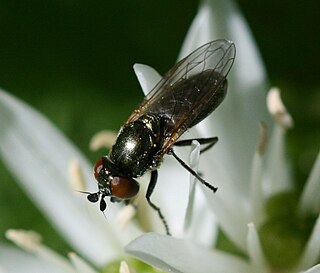
Lejogaster metallina is a Palearctic species of hoverfly.

Parasyrphus lineolus is a Holarctic species of hoverfly.

Parasyrphus vittiger is a species of hoverfly, from the family Syrphidae, in the order Diptera.
Melangyna arctica is a Holarctic species of hoverfly.
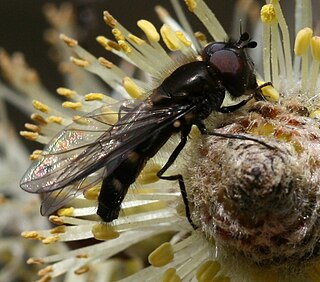
Melangyna quadrimaculata is a European species of hoverfly.

Meligramma guttatum is a Holarctic species of hoverfly.

Epistrophe nitidicollis is a European and North American species of hoverfly.
